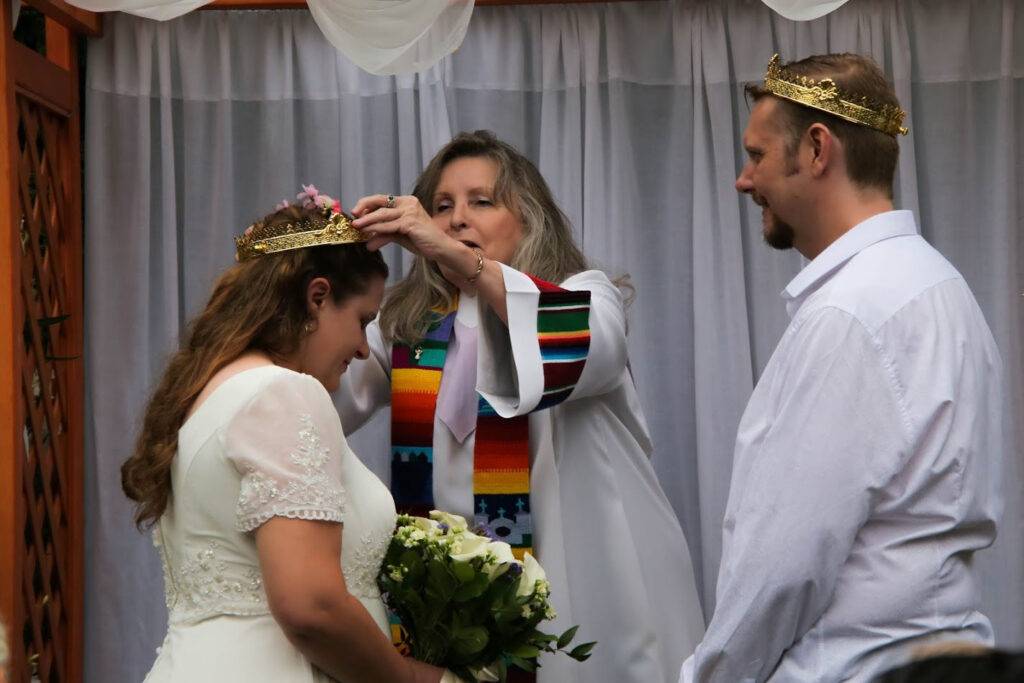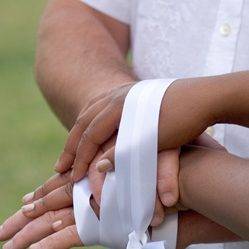
Weddings, Commitment Ceremonies, & Vow Renewals
Soulmate Ceremonies (a division of Magalena Spiritual Healing) believes in the concept of Eukrasia which means harmony and good mixture, ingredients necessary for creating a lasting marriage or union. It derives from an Aramaic word that speaks to spiritual commitment. Eukrasia is a concept that embodies the four physical elements and all aspects of life’s seasons. It epitomizes Union.
I really enjoy taking time in the first consultation with a couple to talk about what makes them who they are, their individual backgrounds—ethnic, religious, philosophical, and their collective vision of their unique ceremony. I take pleasure in helping the happy couple catch a glimpse of the ways in which their individuality can be woven into a rich tapestry of togetherness.
Soulmate Ceremonies reflect readings, traditions, ancient rites, and religious text as appropriate. My services begin by recognizing the circle of marriage with a special blessing. Blending the best of both partners, this celebration is a reflection of the emotional bond of the couple, their family, and their friends. The ceremony concludes with the acknowledgement of the new greater family and the joys the couple will share over the years. Afterwards the couple is presented with a keepsake, a commemorative book, which they are encouraged to read annually on their anniversary as a reminder of their vows.

Following a life-long passion for ceremonies and ritual, I became ordained as an interfaith Minister with Universal Brotherhood Movement (UBM) in 1993. Since 1995, I have been a Minister Director for UBM.
From beautiful natural landscapes alongside flowing creeks to formal church settings, I have created and performed truly unique ceremonies. I have long recognized that each couple brings to their wedding a lifetime of experiences and traditions. My flexible style encompasses the best of two worlds, beautifully merged in a sacred ritual of mind, body, heart, and spirit. In over a decade of officiating, I have earned a reputation for joining couples whose relationships endure the shifting sands of time. I believe that love, in any form, is sacred and I embrace performing both traditional wedding ceremonies and non-traditional celebrations such as commitment ceremonies and vow renewals.
Working alongside seasoned wedding planners and a variety of vendors, I have successfully married and joined couples in Arizona, New Mexico, Georgia, Florida, Colorado, Minnesota, Texas, California and Oregon. I am currently available to perform ceremonies throughout Washington State, contiguous states, and other locales.
Ceremonies & Traditions
The Unity Candle
One of the most common ceremonies. The bride and groom each take a lit candle and simultaneously light a third larger unity candle. They may blow out their individual lights, or leave them lit, symbolizing that they have not lost their individuality in their unity. Stores are now selling elaborate unity candle setups, including a candelabrum that holds the central unity candle higher than the others. You may also have your unity candle personalized with your names and the date, allowing it to be a keepsake from your wedding.
Variations
All guests are given a candle, and the first guest’s is lit. Guests pass the flame until all are lit, and then the bride and groom together light their unity candle. This variation typically includes a proclamation that this ceremony represents the unity of friends and family supporting the couple in their marriage.
The Rose Ceremony
A simple unity ceremony where the bride and groom exchange roses. Other variations: the families exchange roses, the bride and groom exchange roses with their families, the bride and groom exchange roses, then present their mothers with the roses.
The Salt Ceremony
Indian weddings often include a salt ceremony, where the bride passes a handful of salt to her groom without spilling any. He then passes it back to her and the exchange is repeated three times. She then performs the salt exchange with all the members of the groom’s family, symbolizing her blending in with her new family.
Circling
In Eastern European ceremonies, the bride and groom circle the altar three times, which are their first steps together as husband and wife. In Hindu ceremonies, couples circle the fire seven times, sealing their bond. The unbroken circle represents the unbroken commitment to each other.
Broom Jumping
An African-American tradition that has its roots in slavery times when slaves couldn’t marry. Typically the family places the broom on the ground, and the bride and groom jump over it together. The broom can then decorate a place of honor in their home.
Garland Ceremony or Lei Ceremony
The bride and groom exchange garlands of flowers. This is a common part of Indian weddings, where the ceremony is called varmala or jaimala, and represents a proposal by the bride and acceptance by the groom. It also represents their new unity, blessed by nature. In Hawaiian weddings, the bride and groom typically exchange leis. The families may also exchange leis with the couple. Leis represent the love and respect you have for the person you are giving it to, and the unity of the new family.
Would You Like More Information?
Weddings & Commitment Ceremonies
The first consultation and initial exploration is offered at no cost. I’ll be able to meet you in Las Cruces NM and surrounding areas of New Mexico and El Paso, Texas. We can alternatively meet by Skype or similar avenue. I’m happy to offer a free consultation so that you do not feel any pressure to make an immediate decision. I know that you want your ceremony to be just right and that means carefully choosing the right officiant. It is important that all of us feel a good connection and ease of communication. At that consultation I’ll provide you with several helpful handouts on successful marriages/unions.
After you’ve ‘slept’ on our meeting and decided to proceed, I kindly request a one-half non-refundable deposit. When that is received, I’ll email multiple suggested readings and diverse ceremonial possibilities for your consideration.
The next step is for us to schedule a follow-up meeting to discuss all aspects of the ceremony including: your vision; personal preferences; religious, spiritual or non-sectarian considerations; cultural or familial traditions; logistics; ‘flow’ or feeling; rehearsal; processional; recessional; attendants involved; family to be honored; special prayers, remembrances or meditation, etc. I am also able to refer you to other wedding professionals to make your day extra special. My goal and emphasis is to really get to know the two of you in order to create a ceremony of beauty and uniqueness.
Balances are due on or before the wedding date. I will arrive one hour or more ahead of the ceremony to assure that things run smoothly and to instruct any late participants in procedures.
If the wedding is more than 50 miles from Las Cruces NM (including El Paso TX), there will be a small transportation fee based on mileage. I’m happy to accommodate other out-of-state weddings with transportation, meals, and lodging provided. There are no other fees unless you wish for me to obtain special altar items. Gratuities are appreciated for ceremonies that meet and exceed expectations. If you are interested in pre-marital advising to facilitate any issues with communication, money management, decision making, parenthood, etc., I am happy to offer these pastoral counseling services at an additional hourly fee.
Vow Renewals
I also offer a free consultation meeting for vow renewal ceremonies. As these ceremonies usually take a bit less time the fee reflects this. My commitment to you in creating a memorable ceremony is to bring equal enthusiasm, creativity, and energy as if it were the first wedding. Vow Renewal Depends upon the type and size of event Please secure your date as far in advance as you are able so that I may be available to help you. However, should you have a ‘spur of the moment’ wedding, I may be able to help you too or certainly refer you to someone who can.Other Services That I Offer
- Blessing Ceremonies (house, offices, special events)
- Baptisms
- Passing of Loved Ones
- Commitment Ceremonies
Facts & Folklore
The Veil
The wedding veil has evolved over the centuries, and has signified youth, virginity, and modesty. Roman brides were married in swathes of brilliant yellow, while Viking queens wore metal skullcaps. Many Japanese brides still wear the traditional tsuno-kakushi — a white hood that supposedly hides the horns of jealousy. In the United States, George Washington’s daughter Nellie was one of the very first brides to don a veil. Legend has it that Nellie was sitting by a lace-curtained window when one of her father’s aides walked by and fell head over heels in love with her lace-framed face. When the two married, Nellie recreated the effect by donning a lacy veil, and inadvertently set a trend that is still prevalent among Western brides today. Identically Dressed Attendants Keeping evil spirits away from the couple on their wedding day is a recurring theme in wedding tradition. If your attendants complain about having to wear the exact same thing (although these days, of course, they don’t have to match!), tell them this: Bridesmaids used to wear the exact same outfit as the bride so that evil spirits would be confused as to just who was the actual couple.The Headpiece
Headpieces are chosen separately from veiling. Though the earliest brides said their I do’s crowned with floral and herbal wreaths — which continue to be popular, particularly for outdoor and beach ceremonies — there are many other options for the bride today. Eastern Orthodox brides know to look forward to a crowning ceremony when they marry, during which both the bride and groom have ornate crowns placed on their heads; the crowns are blessed and exchanged three times, and when they are removed the couple is officially married. Similarly, the Finnish bride wears a gold crown, which she places on the head of a bridesmaid — while blindfolded — during a reception dance. It is said the lucky maid will be the next to marry, much in keeping with the tradition of American brides tossing the bouquet.The Wedding Kiss
Yes, this is what the big wedding kiss symbolizes–the swapping of souls between the bride and groom. Even earlier than this Christian belief, the Romans used a kiss to seal a contract. The kiss was considered legally binding. What’s more, a bride marrying in the Church of England had to kiss the minister before she smooched the groom.Something Old, New, Borrowed, Blue
The tradition of the bride wearing something old (for continuity), new (optimism for the future), borrowed (happiness), and blue (fidelity, good fortune, and love) on her wedding day stems from an Old English rhyme. The something borrowed comes from the superstition that happiness rubs off, so the bride borrowed something from a happily married woman. Something blue comes from the notion that the shade denotes fidelity, purity and love. Many brides consider their dress to be their something new. There are a few options if cost is a factor: something old – a family heirloom such as your grandmother’s wedding band or string of pearls; a lace handkerchief; an old hat pin secured on the inside of your gown; something borrowed-a family member’s or friend’s headpiece or veil; a piece of your mother’s jewelry; something blue- garter, blue toenail polish, or lingerie. Additional customs relating to luck include: sewing a small pouch filled with a piece of bread, a sliver of wood, a bit of cloth, or a dollar bill into the hem of a bride’s petticoat to protect against future shortages of food, shelter, clothing, or money.The Ring
The circular shape of a wedding ring symbolizes eternal love. Gold represents enduring beauty, purity, and strength, all appropriate marriage sentiments. Why wear the ring on the third finger of the left hand? The ancient Egyptians believed that the vein in that finger ran directly to the heart. As for that big rock of an engagement ring, brides have the Archduke Maximillian of Austria and Mary of Burgundy to thank for that: In 1477 he offered his beloved a diamond as a betrothal gift — the first recorded diamond engagement ring.The Toast
We call it a “toast” when we drink to someone because of an old French custom in which a piece of bread was put in the bottom of the wine cup–for flavor. Partygoers would drink and pass the cup; when it reached the person being toasted, he would drain it–crouton and all.License Requirements
A comprehensive list of County Clerks, Marriage, License Information, Laws, and Requirements.
Wedding & Commitment Testimonials
Adelia & Margie
New Mexico
Amy & Sanjay
Arizona
Marta & Roch
Michigan
Christina & Hans-Peter
Colorado
Jennifer & Jason
Arizona

